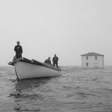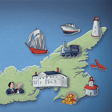
Heave Away! Why sea shanties bring the world together
From Black stevedores in the American Deep South, to Hawaiian Inuit dances, to folk singers on Canada's East Coast music scene -- discover the fascinating world of sea shanties in a special episode by Canada's History contributor Jonah Grignon. With music recorded live by the Bytown Sea Shanty Collective.
Music credits:
Traditional shanties performed by the Bytown Sea Shanty Collective, used with permission of the artists
"Heave Away," traditional, performed by Roger McGuinn, licensed from freemusicarchive.org
"Hawaiian Ciribiribin" composed by Alberto Pestalozza, recorded in 1919 by Louise and Ferera, public domain https://publicdomainreview.org/collection/hawaiian-ciribiribin-1919/
"Medley of sea songs," traditional, recorded in 1913, public domain https://www.loc.gov/item/jukebox-133664/
"Medley of sea chanties," traditional, recorded in 1914, public domain https://www.loc.gov/item/jukebox-649564/












